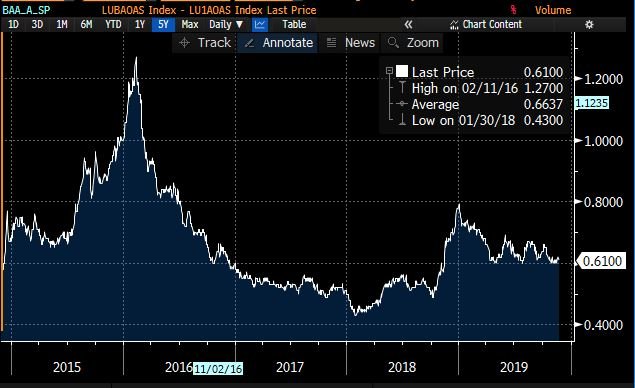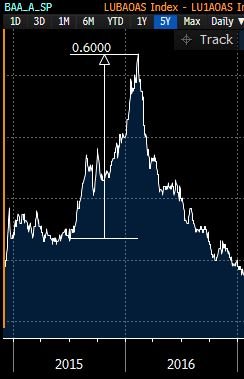A discussion of the BBB credit explosion, its genesis, implications and likely outcomes in thread form. 1/x
(Of interest to @JodyLurie @kevinmuir and maybe even @KeithMcCullough ;-)
(Of interest to @JodyLurie @kevinmuir and maybe even @KeithMcCullough ;-)
In Dec 2011, BBB credits were 43% of the BBG/Barc US Credit Index--today that number is 55%. There are now $3.2T of USD BBB rated credit incl BBB+, BBB, and BBB-
I picked Dec 2011 for data availability on index details and am using S&P& #39;s rating style. 2/x
I picked Dec 2011 for data availability on index details and am using S&P& #39;s rating style. 2/x
To recap -ive BBB thesis (described in this note https://themacrotourist.com/dudley-does-his-best-icahn/),">https://themacrotourist.com/dudley-do... idea is that BBB debt is close to the threshold between investment grade and high yield. If a BBB issuer is downgraded to BB, IG-only investors have to sell, which causes sharp drop in mkt val. 3/x
If downgrades happen across a large number of credits, the losses from forced selling could be substantial and hit the entire ratings category. Again, that& #39;s the doomsday BBB negative thesis, not what I/we believe. 4/x
Our thesis is this: while expansion of BBB ratings category is a concern, avoiding or shorting the whole sector gives up massive amt of carry in exchange for trying to profit off of an unlikely event with uncertain timing. 5/x
I& #39;ll break down this thesis into:
A) Discussion of the growth of BBB and why it& #39;s not as concerning as scary headline stats look
B) Cost of avoiding/shorting BBB names
C) An alternative to reduce risk more efficiently. 6/x
A) Discussion of the growth of BBB and why it& #39;s not as concerning as scary headline stats look
B) Cost of avoiding/shorting BBB names
C) An alternative to reduce risk more efficiently. 6/x
A) Large portion of BBB incr stemmed from ratings agencies structural downgrade of large bank subordinated debt into the BBB category, where it& #39;s effectively capped. Banking sub debt accounts for 4.5 percentage points (pp) of the 11.7pp increase in BBB holdings. 7/x
A) The 9.0% of the BBB index isn& #39;t going to BB anytime in the foreseeable future, including , as it& #39;s Globally Systemically Important Banks (GSIBs) are WAAAY safer creditwise today than in 2011. Moreover GSIBs need access to IG markets, so they& #39;ll protect BBB sub ratings. 7/x
A) 3% of the BBB index is AT&T, which went BBB to buy TWX. AT&T is deleveraging, has plenty of excess cashflow to do so, and has minuscule risk of going to BB. Between AT&T and the GSIBs, we’ve now safely explained 7.5pp of the 11.7pp incr in BBB credits since 2011. 8/x
A) Utilities also make up 4% of the BBB index. Pretty silly to think regulated public power is going to get whacked by economic downturn hard enough to take multi-notch ratings hit. 9/x
A) Finally, the portion of BBB+ rated debt, the piece least likely to end up as high yield has actually increased since 2011. Granted, the BBB- portion has also increased, and it’s this stuff we should be paying attention to, which I’ll get to in part (C). 10/x
B) If we’re weighing whether we should avoid or short BBB rated debt altogether, the first step is to understand the cost of that trade. Today, spread between BBB and A index is currently +61bps, which is low historically, but still a big give up w/absolute yields <3% 11/x
B) The judgment isn’t whether BBBs will weaken in a downturn, but whether any weakening overwhelms the 61bps carry advantage. In fixed income, carry is king for the long run returns. 12/x
B) BBBs will underperform in a down-in-credit scenario, but you either have to time the trade PERFECTLY or at least closely enough to not be hurt by -61bps carry vs As. 13/x
B) Scenario analysis time:
Let’s say 50% of “unexpl” increase in BBBs 2011-2019 gets cut to BB (4.2% of idx). Let& #39;s also say that 5% of the 2011 index gets cut (4.4% of idx).
Let& #39;s also say that market value impact of that cut is 10%.
4.3%*10% =0.4% mkt value loss
14/x
Let’s say 50% of “unexpl” increase in BBBs 2011-2019 gets cut to BB (4.2% of idx). Let& #39;s also say that 5% of the 2011 index gets cut (4.4% of idx).
Let& #39;s also say that market value impact of that cut is 10%.
4.3%*10% =0.4% mkt value loss
14/x
B) Let& #39;s also say non-downgraded BBB names widen 60bps vs As, as in late 2015.
Total mkt value loss:
-0.4% (downgrade) + -1.8% (widening) = -2.2%
-2.2%/61bps carry = 3.6yrs
EXTREME scenario, you have to nail timing to w/in <4yrs to profit frm avoiding/shorting all BBBs 15/x
Total mkt value loss:
-0.4% (downgrade) + -1.8% (widening) = -2.2%
-2.2%/61bps carry = 3.6yrs
EXTREME scenario, you have to nail timing to w/in <4yrs to profit frm avoiding/shorting all BBBs 15/x
B) What are the odds of this extreme downgrade scenario occurring? Even the most pessimistic couldn& #39;t honestly peg the odds above 75%. Then you need to nail the timing w/in <2.7yrs to profit. Point is that carry overwhelms ability to time the cycle perfectly. 16/x
B) Over the last year, if you made this "smart" trade, you underperformed -269bps. In IG credit. Ouch.
Finally, spreads are dynamic and this analysis is path dependent, so any widening makes the trade less appealing. 17/x
Finally, spreads are dynamic and this analysis is path dependent, so any widening makes the trade less appealing. 17/x
C) As an alternative to painting the entire BBB sector with the same brush, real fixed income PMs can and do seek to underweight specific names. And some of us are pretty good at it. 18/x
C) At this point in the cycle, we can earn decent carry, have less give-up, and still avoid downgrade risk by owning stable-EBITDA sectors and names w/in BBB space.
O/w: rail, bank sub-debt, consumer-facing telecom, pharma, REIT, utilities
U/w: autos, energy, retail
19/x
O/w: rail, bank sub-debt, consumer-facing telecom, pharma, REIT, utilities
U/w: autos, energy, retail
19/x
C) Fixed income isn& #39;t all or nothing. Those who claim it is usually end up bleeding carry through most of their careers. Credit bears have to pay a big tax to hold their positions.
19/19 Fin.
19/19 Fin.
PS: Additional discussion https://twitter.com/lhamtil/status/1179775544063381504">https://twitter.com/lhamtil/s...

 Read on Twitter
Read on Twitter












